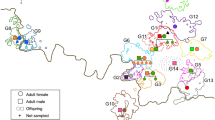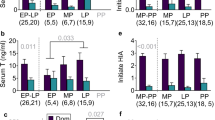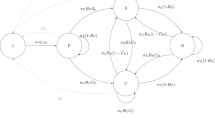Abstract
In most social mammals, males leave their natal group to breed in other groups whereas females commonly remain in the same group throughout their lives1. In a few species however, females usually transfer between groups during adolescence1. The functional significance of sex differences in dispersal and their connection, if any, to the avoidance of inbreeding is disputed2–7. Here I show that in polygynous mammals where females commonly remain to breed in their natal group, thdr average age at first conception typically exceeds the average period of residence of adult males in breeding groups. In contrast, where females usually transfer to breed in other groups, the average residence of breeding males or of resident male kin groups typically exceeds the average age of females at first conception. These results support the suggestion that female mammals commonly transfer to avoid inbreeding with their father or other close relatives, although female dispersal may also occur for other reasons8,9.
This is a preview of subscription content, access via your institution
Access options
Subscribe to this journal
Receive 51 print issues and online access
$199.00 per year
only $3.90 per issue
Buy this article
- Purchase on Springer Link
- Instant access to full article PDF
Prices may be subject to local taxes which are calculated during checkout
Similar content being viewed by others
References
Greenwood, P. J. Anim. Behav. 28, 1140–1162 (1980).
Moore, J. & Ali, R. Anim. Behav. 32, 94–112 (1981).
Moore, J. Int. J. Primatol. 5, 537–589 (1984).
Pusey, A. E. & Packer, C. R. in Primate Societies (eds Smuts, B. B. et al.) 250–266 (University of Chicago Press, 1987).
Pusey, A. E. Trends Evol. Ecol. 2, 295–299 (1987).
Wrangham, R. W. Behaviour 75, 262–300 (1980).
Johnson, C. W. Oecologia 69, 626–627 (1986).
Crockett, C. M. Female Primates: Studies by Women Primatologists (ed. Small, M. F.) 159–173 (Liss, New York, 1984).
Marsh, C. W. Nature 281, 568–569 (1979).
Frame, L. H., Malcolm, J. R. & van Lawick, H. Z. Tierpsychol. 50, 225–245 (1980).
Malcolm, J. R. & Marten, K. Behav. Ecol. Sociobiol. 10, 1–13 (1982).
Struhsaker, T. T. The Red Colobus Monkey (University of Chicago Press, 1980).
Strusaker, T. T. & Leland, L. in Advances in the Study of Behavior (eds Rosenblatt, J. et al.) 159–225 (Academic, New York, 1979).
Nishida, T. T. & Hiraiwa-Hasegawa, M. in Primate Societies (eds Smuts, B. B. et al.) 165–178 (University of Chicago Press, 1987).
Wrangham, R. W. in Primate Societies (eds Smuts, B. B. et al.) 282–296 (University of Chicago Press, 1987).
Ohsawa, H. African Studies Monographs 2, 53–71 (1982).
Kummer, H. Social Organization of Hamadryas Baboons (University of Chicago Press, 1968).
Sigg, A., Abbeglen, J. J. & Dasser, V. Primates 23, 473–487 (1982).
Stewart, K. & Harcourt, A. H. in Primate Societies (eds Smuts, B. B. et al.) 155–164 (University of Chicago Press, 1987).
Clutton-Brock, T. H. & Harvey, P. H. in Growing Points in Ethology (eds Bateson, P. P. G & Hinde, R. A.) 195–237 (Cambridge University Press, 1976).
Packer, C. R. Anim. Behav. 27, 1–36 (1979).
Waser, P. M., Austad, S. N. & Keane, B. Am. Nat. 128, 529–537 (1986).
Budnitz, N. & Dainis, K. Lemur Behavior (eds Tattershall, I. & Sussman, R. W.) (Plenum, New York, 1975).
Pusey, A. E. & Packer, C. R. Behaviour 101, 275–310 (1987).
Robinson, J. G. & Janson, C. H. in Primate Societies (eds Smuts, B. B. et al.) 69–82 (University of Chicago Press, 1987).
Roosmalen, van M. G. M. Thesis, Rijksinstitut voor Naturbeheer Arnhem, The Netherlands (1980).
Hoogland, J. L. Science 215, 1639–1641 (1982).
Blouin, S. F. & Blouin, M. Trends Evol. Ecol. 3, 230–232 (1988).
Armitage, K. in Ecological Aspects of Social Evolution (eds Rubenstein, D. I. & Wrangham, R. W.) 303–331 (Princeton University Press, 1986).
Clutton-Brock, T. H., Albon, S. D. & Guinness, F. E. in Reproductive Success (ed. Clutton-Brock, T. H.) 325–343 (University of Chicago Press, 1988).
Cords, M. in Primate Societies (eds Smuts, B. B. et al.) 98–111 (University of Chicago Press, 1987).
Dunbar, R. M. Reproductive Decisions (Croom Helm, London, 1988).
Hardy, S. B. The Langurs of Abu (Harvard University Press, 1977).
Rudran, R. Folia Primatol. 19, 166–192 (1975).
Jarman, P. & Southwell, C. D. in Ecological Aspects of Social Evolution (eds Rubenstein, D. I. & Wrangham, R. W.) 399–428 (Princeton University Press, 1986).
Richard, A. F. in Primate Societies (eds Smuts, B. B. et al.) 25–33 (University of Chicago Press, 1987).
Henzi, S. D. & Lucas, J. W. Folia Primatol. 33, 220–235 (1980).
Altmann, J., Hausfater, G. & Altmann, S. A. in Reproductive Success (ed. Clutton-Brock, T. H.) 403–418 (University of Chicago Press, 1988).
Melnick, D. J., Pearl, M. C. & Richard, A. F. Am. J. Primatol. 7, 229–243 (1984).
Sugiyama, Y. in Advances in the Study of Behavior Vol. 7 (eds Rosenblatt, J. S. et al.) 255–284 (Academic, New York, 1976).
Itani, J. in Primate Socialization (ed. Poirier, F. E.) 165–171 (Random House, New York, 1972).
Dittus, W. in Socioecology and Psychology of Primates (ed. Tuttle, R. H.) 125–151 (Mouton, The Hague, 1975).
Dittus, W. Behaviour 63, 281–322 (1977).
Harvey, P. H. & Clutton-Brock, T. H. Evolution 39, 559–581 (1985).
Klingel, H. J. Reprod. Fert. Suppl. 23, 7–11 (1974).
Berger, J. Wild Horses of the Great Basin (University of Chicago Press, 1986).
Gittleman, J. Am. Nat. 127, 744–771 (1986).
Crockett, C. M. & Eisenberg, J. F. in Primate Societies (eds Smuts, B. B. et al.) 54–68 (University of Chicago Press, 1987).
Struhsaker, T. T. & Leland, C. in Primate Societies (eds Smuts, B. B. et al.) 83–97 (University of Chicago Press, 1987).
Wrangham, R. W. in Ecological Aspects of Social Evolution (eds Rubenstein, D. & Wrangham, R. W.) 352–378 (Princeton University Press, 1986).
Robinson, J. G. Behavl Ecol. Sociobiol. 23, 187–197 (1988).
Author information
Authors and Affiliations
Rights and permissions
About this article
Cite this article
Clutton-Brock, T. Female transfer and inbreeding avoidance in social mammals. Nature 337, 70–72 (1989). https://doi.org/10.1038/337070a0
Received:
Accepted:
Issue Date:
DOI: https://doi.org/10.1038/337070a0
This article is cited by
-
Short and long-term costs of inbreeding in the lifelong-partnership in a termite
Communications Biology (2022)
-
Genetic structure and population history in two critically endangered Kaua‘i honeycreepers
Conservation Genetics (2021)
-
Female chimpanzees giving first birth in their natal group in Mahale: attention to incest between brothers and sisters
Primates (2021)
-
A new classification of mammalian uni-male multi-female groups based on the fundamental principles governing inter- and intrasexual relationships
Behavioral Ecology and Sociobiology (2021)
Comments
By submitting a comment you agree to abide by our Terms and Community Guidelines. If you find something abusive or that does not comply with our terms or guidelines please flag it as inappropriate.



